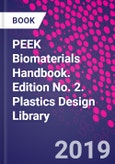PEEK biomaterials are currently used in hundreds of thousands of spinal fusion patients around the world every year. Durability, biocompatibility, and excellent resistance to aggressive sterilization procedures make PEEK a polymer of choice, replacing metal in orthopedic implants, from spinal implants and knee replacements to finger joints and dental implants.
The new edition of this authoritative work sees the book expand from 17 chapters to 26 chapters to match the expansion in applications in PEEK-from spinal cages to spinal rods and disc replacements; hip and knee joint replacement; dental; trauma; and sports medicine. New PEEK formulations have been developed incorporating hydroxyapatite, additives to combat infection, and surface grafted polymers to improve lubrication. The book also covers additive manufacturing, which has made significant inroads with PEEK in the past 5 years as well by introducing the prospect of patient-specific implants.
Like the 1st edition, the updated Handbook brings together experts in many different facets related to PEEK clinical performance as well as in the areas of materials science, tribology, and biology to provide a complete reference for specialists in the field of plastics, biomaterials, medical device design, and surgical applications.
Useful for materials scientists and biomedical engineers, both in industry and academia, the book is a one-stop shop for information on PEEK as a biomaterial-including in-depth coverage of materials properties-while also providing cutting-edge information on applications and combinations of the material.
Please Note: This is an On Demand product, delivery may take up to 11 working days after payment has been received.
Table of Contents
Part 1 PEEK Foundations, Properties, and Behavior 1 An Overview of PEEK Biomaterials 2 Synthesis and Processing of PEEK for Surgical Implants 3 Compounds and Composite Materials 4 Morphology and Crystalline Architecture of Polyaryletherketones 5 Fracture, Fatigue, and Notch Behavior of PEEK 6 Chemical and Radiation Stability of PEEK 7 Additive Manufacturing of Polyaryletherketones
Part 2 Bioactive PEEK Materials 8 Biocompatibility of PEEK Polymers 9 Bacterial Interactions With PEEK 10 Thermal Plasma Spray Deposition of Titanium and Hydroxyapatite on PEEK Implants 11 Surface Modification Techniques of PEEK, Including Plasma Surface Treatment 12 Bioactive Polyaryletherketone Composites
Part 3 PEEK Applications in Medical Devices 13 Porosity in PEEK 14 Phospholipid Polymer-Grafted Poly(Ether-Ether-Ketone) by Self-Initiated Surface Grafting 15 Development and Clinical Performance of PEEK Intervertebral Cages 16 Dynamic Stabilization and Semirigid PEEK Rods for Spinal Fusion 17 Applications of Polyetheretherketone in Arthroscopy 18 Polyetheretherketone in Trauma 19 Applications of Polyetheretherketone in Craniomaxillofacial Surgical Reconstruction 20 Applications of PEEK in the Dental Field 21 Isoelastic PEEK Implants for Total Joint Replacement 22 Biologic Responses to Polyetheretherketone (PEEK) Wear Particles 23 Biotribology of PAEK Bearings in Multidirectional Pin-on-Disk Testers 24 PEEK Biomaterials in Total Joint Replacement 25 PEEK-on-Ceramic Cervical Disc Arthroplasty 26 FDA Regulation of PEEK Implants
Authors
Steven M. Kurtz Director, Implant Research Center and Associate Professor, Drexel University; Research Assistant Professor, Thomas Jefferson University, Philadelphia, PA, USA. Dr. Kurtz has been researching ultra-high molecular weight polyehtylene(UHMWPE) for use in orthopedics for over 10 years. He has published dozens of papers and several book chapters related to UHMWPE used in joint replacement. He has pioneered the development of new test methods for the material in orthopedics. Dr. Kurtz has authored national and international standards for medical upgrade UHMWPE.As a principle engineer at Exponent, an international engineering and scientific consulting company, his research on UHMWPE is supported by several major orthopedic manufacturers. He has funding from the National Institutes for Health to stdy UHMWPE changes after implanatation in the body, as well as to develop new computer-based tools to predict the performance of new UHMWPE materials.
Dr. Kurtz is the Director of an orthopedic implant retrieval program in Philadelphia which is affiliated with Drexel University and Thomas Jefferson University. He teaches classes on the performance of orthopedic polymers (including UHMWPE) at Drexel, Temple, and Princeton Universities.








